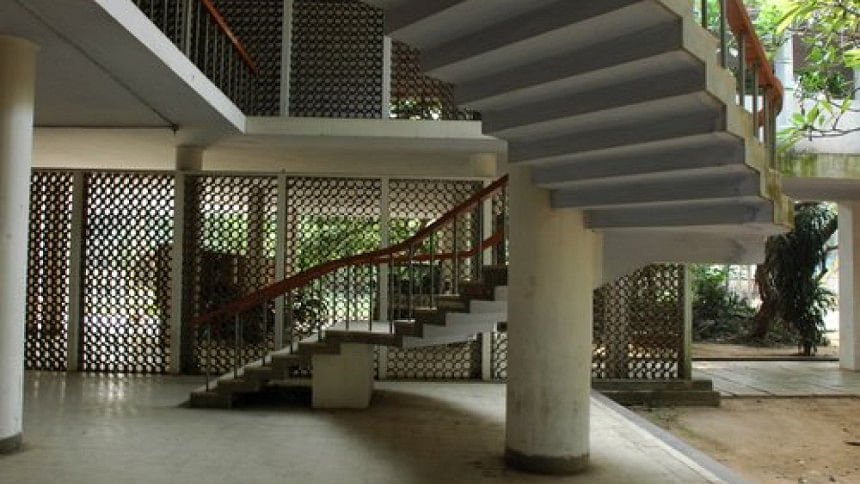The silent revolt that no one talks about

There is a building in Dhaka that most of us pass by without a second glance. It doesn't scream for attention. It doesn't compete with the shiny towers of our neoliberal skylines. It stands quietly, almost shyly, under the canopy of trees at Dhaka University. But what it holds inside—historically, symbolically, psychologically—is nothing less than a revolt. Not with banners or bullets, but with brick and silence. I'm speaking, of course, of the Institute of Fine Arts, designed by Muzharul Islam and completed in 1956. In a time when East Pakistan was caught in the tightening grip of West Pakistan's ideologies, this building emerged, not as a reaction, but as a radical proposition.
Most people at the time didn't fully grasp what had happened. The building was "just architecture," a place for artists to study, to paint, to sculpt. It looked clean, modest, and rational. But it was anything but ordinary. At a time when architecture echoed the imperial leftovers of British neoclassicism—with their hierarchical axes, pompous symmetry, and enclosed monumental facades—the fine arts institute did something radical: it opened itself to the courtyard, to the sky, to trees and human movement. It brought life into the plan. No grand staircase, no ceremonial façade, no temple-like portico, no restriction on walking around the place. Instead, a shaded walkway, porous boundaries, a humble yet dignified spatial democracy.
Psychologically, this space broke with authority. Where colonial architecture was designed to intimidate—to control through verticality, scale, and detachment—this building offered a horizontal intimacy. It invited people to linger, not march. You could enter from multiple sides; it had no "official" front. The courtyard was not ornamental; it was simultaneously a spatial breathing room and a studio, evoking a distinctly Bangalee sense of openness and collective presence. It signalled, subtly but unmistakably, a return to ourselves. It was, quite literally, an architecture of freedom.
Philosopher and social theorist Henri Lefebvre argues that liberation manifests through two interdependent media: the linguistic and the spatial (The Production of Space, 1991). The 1952 Language Movement was our linguistic revolt—bloody, visible, undeniable. But what followed just four years later was our spatial revolt. The fine arts institute did for space what the Language Movement did for speech: it returned us to ourselves. It reminded us, silently, that we were not what the colonial powers—first British, then Pakistani—tried to make us. It reminded us that we had a consciousness before we had a country, and that consciousness needed space where to live, breathe, and become.
The genius of Muzharul Islam was not in spectacle, but in restraint. He didn't reach for arches, Mughal motifs or colonial symmetry. Instead, he turned to local materials: handmade brick, indigenous proportions, shaded verandas, jaali-like wall perforations. Yet, these elements were not nostalgic—they were transformed, modernised, made metaphysically new. He constructed a space that felt ancient without looking backwards, and felt modern without betraying its roots. In doing so, he performed an act of resistance that was both spatial and civilisational.
This, I argue, was our mnemonic rupture—a moment where memory became form. Before we gained territorial independence in 1971, we had already begun to liberate our psyche. The fine arts institute was not just a building, it was a premonition. It knew, before we did, that to become a nation, we had to reclaim more than our land; we had to reclaim our spatial consciousness, and our cultural and existential memory. We had to unlearn colonial monumentality and reimagine ourselves not as subjects of empire, but as carriers of a humanist legacy deeper and older than any imposed state ideology.
In my ongoing work, How Architecture in Bangladesh Became Metaphysically Modern, I argue that this building marks the first real postcolonial reorientation of space in our context. It didn't just import modernism from the West. It translated it into a local metaphysics, a way of being that was simultaneously forward-looking and deeply grounded. It answered Muzharul Islam's timeless question, "How do we enter the 21st century?" A question that, as Kazi Khaleed Ashraf observes, carries within it a quiet hesitation: what must we take with us? What must we abandon? What memories, what shadows, what principles still matter?
Today, too often, we associate liberation only with war, politics, and slogans. But the fine arts institute reminds us that liberation also happens in silence, in shadow, in slow-burning wisdom. It teaches us that architecture is not passive. It can fight, it can remember, it can restore. Before we picked up rifles, we built this. Before our maps changed, our minds had already begun to transform.
So perhaps it's time we ask: what other revolutions have we forgotten? What other sacred beginnings have we walked past without knowing? The Institute of Fine Arts does not demand to be remembered. It simply stands as proof that space can speak, and sometimes, silence is the loudest revolt of all.
Maruf Ahmed is an architect and a lecturer at Khulna University of Engineering and Technology (KUET).
Views expressed in this article are the author's own.
Follow The Daily Star Opinion on Facebook for the latest opinions, commentaries and analyses by experts and professionals. To contribute your article or letter to The Daily Star Opinion, see our guidelines for submission.

 For all latest news, follow The Daily Star's Google News channel.
For all latest news, follow The Daily Star's Google News channel. 





Comments